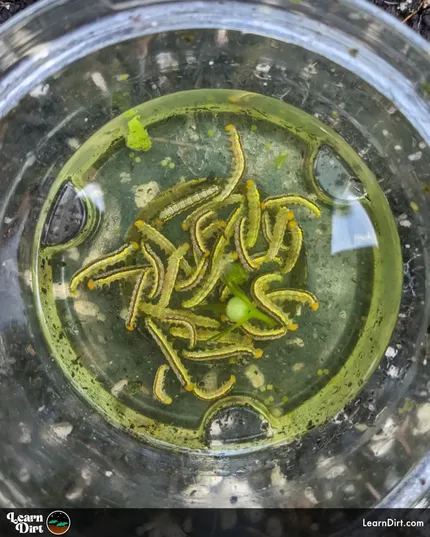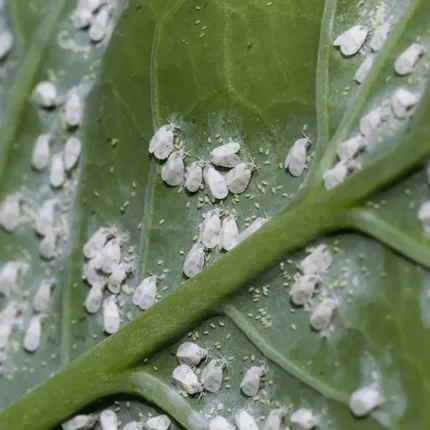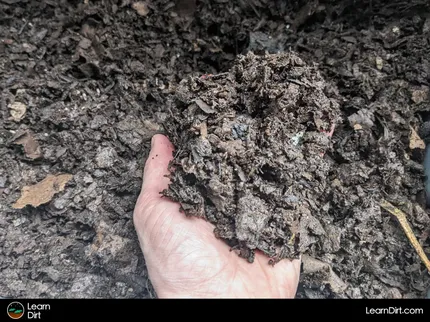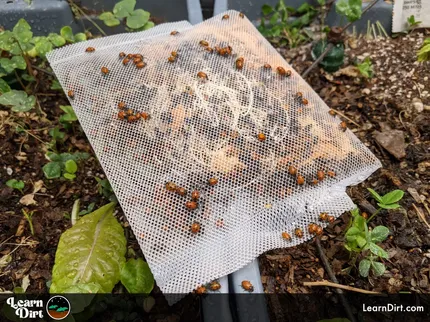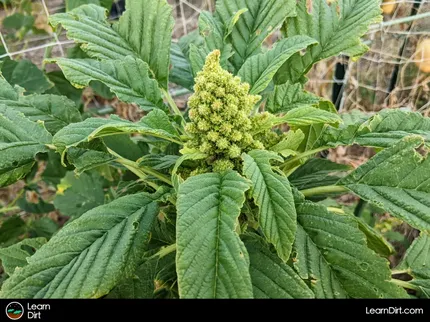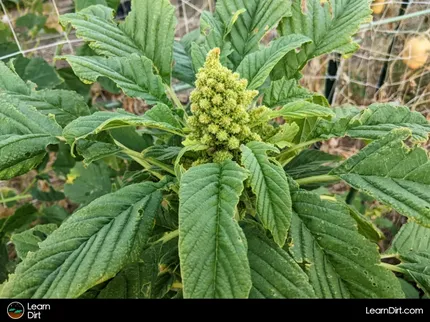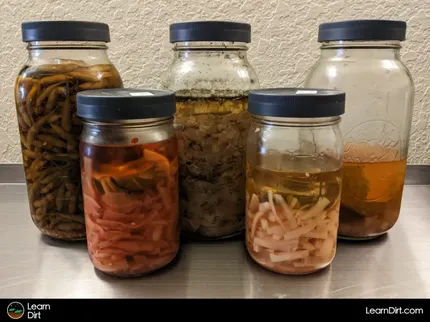Table of Contents
- What Is a Thrip?
- Thrip Damage
- Thrip Lifecycle
- How to Get Rid of Thrips
- How to Prevent Thrips
- FAQs
- Final Thoughts...
* Our articles never contain AI-generated slop *
Wondering what thrips are and how to deal with them? Keep reading, I've got great solutions for ya!
I recently had a bad thrip infestation that devastated my plants and left them dead and sad within days.
They especially enjoyed wreaking havoc on my millet cover crop, and I was completely surprised to see so much damage as I didn't catch them early enough. Hint: this might indicate that millet is worth a try as a trap crop for thrips.
Disclaimer: This post may contain affiliate links. Refer to the privacy policy for more information.
Here we'll delve into what thrips are, what they do, and most importantly - some ways you can actually get rid of them.
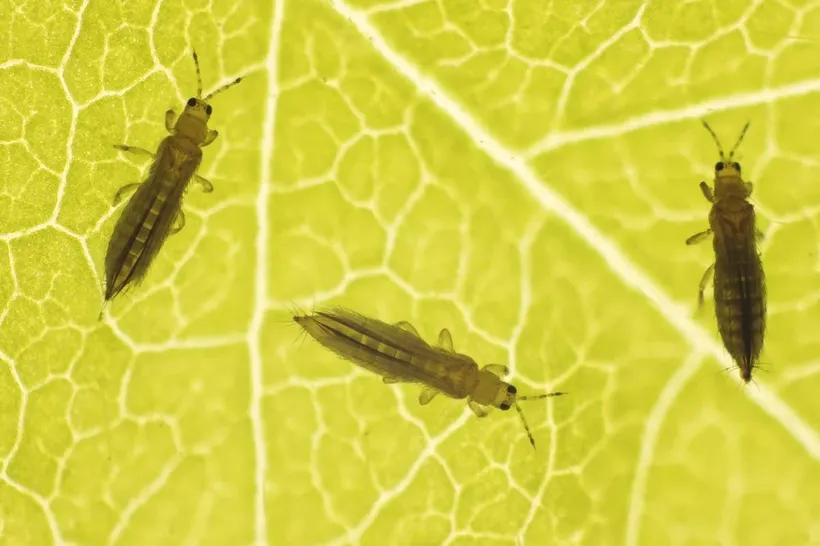
What Is a Thrip?
Thrips are sap-suckers. They latch onto plant tissue, especially leaves, and suck plants of their nutrients and moisture.
If allowed to grow in size, a thrip outbreak can be devastating to plants which might not be capable of growing faster than the thrips can multiply.
They are especially a problem in greenhouses and indoors, where natural thrip predators aren't present.
What Do Thrips Look Like?
This is a magnified photo of a common thrip. You'll immediately notice that they are longer and skinnier than most other garden pests - helpful for identifying them.
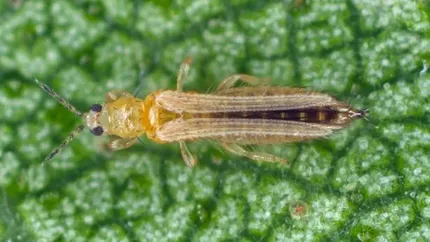
Thrip Size
Most thrips are generally small, just a couple millimeters in length.
Join The Grower's Community
Your space to connect, learn, and belong 🌱
Check It Out!
Some thrip species are so small they can barely be seen with the naked eye (such as Aptinothrips stylifer), while other rare species (like Phasmothrips reticulatus) can be up to 14mm in length!
Thrip Eggs
Thrips lay their eggs inside plant tissue on the underside of leaves or in flowers, so they can be hard to see and correctly identify.
Instead, look for adult thrips to identify and gauge population.
Thrip Poop on Leaves
Species
Shocker - there are over 7,000 know species of thrips! Only a few of them are known to be serious pests, however.
If you're struggling with thrips, it's likely one of the pest species, such as:
- Avocado Thrips
- Banana Thrips
- Chilli Thrips
- Citrus Thrips
- Gladiolus Thrips
- Greenhouse Thrips
- Melon Thrips
- Onion Thrips
- Tobacco Thrips
- Western Flower Thrips
Thrip Damage
Thrip damage can help you quickly identify what type of pest you're plagued by.
So what does thrip damage look like?
Thrip Lifecycle
Where Do Thrips Come From?
Do Thrips Live in Soil?
Thrips live out the start and end of their lives on plant leaves, but in the middle of their lives they do spend time in soil or under leaf litter.
These are the inactive prepupal and pupal stages, where thrips can't move and spend about 5 days becoming adults before returning back to feed on plant leaves again and lay eggs.
Unfortunately, this means its easy to accidentally bring thrips into your greenhouse or grow room in soil without realizing it.
Fortunately, it also means that thrips ore susceptible to soil-borne nematodes because the thrips spend time in the soil where nematodes can reach them. See the section on nematodes below for more on this.
How to Get Rid of Thrips
Blast 'Em!
Thrips are not that great at holding onto leaves and stems in the face of a high-pressure water blast.
Grab yourself a pump sprayer, pump it up real good, and blast the thrips off your plants. It may take a little while to target them all, but this can effectively knock a majority of the thrips off your leaves and stems immediately - allowing plants to recover before pest populations bounce back.
This works really well for flowering cannabis, where don't want soap in your buds. Just be sure that your lights and fans will be on after, or that you've got some sunny warm days ahead for the buds to dry out. The last thing you want is to trade thrips for mold.
Given the time to dry after some high-pressure water blastin', your plants should be able to bounce back very quickly. This also helps get rid of thrip poop which nobody wants on their plants.
Pair a water blasting with the castille soap application mentioned above, as a way to clean off your leaves a day or two after you soap 'em.
What Eats Thrips?
Now you're asking the right questions. You must be a systems thinker into holistic approaches and ecosystem balance.
We always advocate for balanced approaches here, rather than reactionary chemical use or time-intensive bug-squishing. Prioritization of long-term systemic solutions is how healthy ecology is achieved.
Great news! There are MANY creatures which eat thrips and will target them better than chemicals ever could.
Let's talk about some of the common beneficial bugs for thrips that will help balance your ecosystem, and keep thrip breakouts under control naturally.
Dig Cool Merch?
Do Ladybugs Eat Thrips?
Ladybugs or Lady Beetles are a generalist species which will absolutely eat thrips, plus a whole bunch of other pests including but not limited to:
- Thrips
- Aphids
- Mealybugs
- Leafhoppers
- Alfalfa Weevils
- Chinch Bugs
- Grape Root Worm
- Certain Mites
Amblyseius Cucumeris Controls Thrips
I like using predatory mites like this for indoor applications, as they will stay in isolated areas better than ladybugs will.
Always check if predatory species are invasive in your area before releasing beneficials outside!
Amblyseius Cucumeris is a great preventative mite because it feeds on immature stages of thrips (larvae) as well as some common and obnoxious mites you may encounter, including but not limited to:
- Broad Mites
- Spider Mites
- Russet Mites
- Cyclamen Mites
When there aren't adequate pests populations available for your Amblyseius Cucumeris friends, they'll happily switch to pollen as a main food source just like ladybugs.
Be sure to provide numerous choices of flowering plants for your predators to utilize as their backup food source when pest populations dip.
Minute Pirate Bugs
Orius insidiosis, known as the Minute Pirate Bug, is a voracious eater with an appetite for many common garden pests, thrips included.
Also on the menu for pirate bugs are aphids, spider mites, and moth eggs, among others.
Estimates for how many thrips they'll eat range from 10-30 per day, however they kill far more than they eat, sometimes up to 100 thrips per day.
These critters are incredibly effective at thrip control, and I especially love using them in greenhouses, indoor grow tents, and grow rooms where they can be contained so they stick around longer.
Providing supplemental food is a good idea for most predatory insects, so they remain around after most pests are eliminated. This is because pests will inevitably never be fully eliminated and their populations will always bounce back. If you can supplement their diet when pests dwindle, pirate bugs will still be around as thrips bounce back.
Many beneficial insect businesses offer supplemental food options to keep predators well-fed when there aren't enough pests to chow down on.
I also always suggest having flowering plants around for predators to feed on when prey populations drop. Orius species will consume pollen and nectar from flowers when food is scarce.
It's worth mentioning here that Pirate Bugs can and do bite humans and pets, and their bites are reported to not be much fun.
That said, this is likely not much concern outdoors, or in contained greenhouses, grow tents, and grow rooms. It might be a concern if you release them in an open area in your house such as a windowsill herb garden, where they can't be easily contained. Remember, they would still much rather bite thrips than bite you, and I've never had an issue with them before.
Nematodes For Thrips
Trips spend their prepupal and a pupal stages in the soil, and the nematode species Steinernema feltiae (SF) is highly effective at stopping thrip pupae in this soil stage.
Adding these nematodes for thrips to your soil can help get ahead of the problem, and prevent the continued growth of thrip populations.
While you'll likely have to pair SF nematodes with another beneficial predator species for full control, nematodes can still be a powerful ally in attaining a balanced ecosystem that's not overrun by thrips.
Lacewings
It's not the adult lacewings that feed on thrips, but the lacewing larvae when they're young.
Larvae will crawl up and down plants seeking out thrips, aphids, whiteflies, spider mites, mealybugs, caterpillar eggs, and other pests to devour.
They are voracious, and their appetite earns them a spot on the list of friends of gardeners and farmers.
Adult lacewings subsist off of pollen and nectar, so if you'd like them to reproduce and give you future generations of larvae you'll want to provide a diversity of flowers for them to access, and be sure that you always have something flowering in your garden or greenhouse to keep adult lacewings well-fed and reproducing.
Hypoaspis Miles
Amblyseius Swirskii
Insecticidal Soap
Grab yourself a bottle of castille soap like Bronner's, put a few squirts in a spray bottle and fill it up the rest of the way with water.
Give it a shake, and then spray your afflicted plant leaves and stems every day or two. Soap is pretty effective at drying out and killing most things with exoskeletons, and thrips are no exception.
Note that the soap will leave a white residue of saponins on your leaves, which you'll want to wash off before consuming.
Most plants tolerate these castille soap foliar sprays quite well, with a few exceptions. If your plant looks worse after soaping it up a few times, discontinue use and consult your plant doctor immediately.
In a lot of cases if your thrips are really sucking the life from a plant, a few targeted applications of soap and a few days to recover will often see plants perk back up and look healthier than they have in a while.
One note here - if you're growing cannabis and it's already in the flowering stage, do not apply soap. It will seep deep into the flower buds and be very difficult to wash away. Not to mention that flower buds are best kept as dry as possible to prevent mold. This may apply to other flowering species as well if you plan to consume the flowers.
Neem Oil and Thrips
Neem can be a helpful tool to have in your IPM holster, and is somewhat effective against thrips.
It's best to apply it every few days, hit every part of every plant (especially undersides of leaves) and don't let up until their population shrinks significantly.
Neem oil is organic, but it's not harmless. It contains a strong chemotoxin (azadirachtin) produced by the neem tree to repel insects, which is extracted from its seeds. Skin contact can cause irritation - wear gloves and consider eye protection and a mask. Never ingest neem, and try not to inhale the spray from it either.
How to Prevent Thrips
Thrips can come in on plants from nurseries, in bags of soil, and in leaves and mulch.
If you grow houseplants, starts, cannabis, rare orchids, or anything else indoors, exercise caution when bringing new plants and soil inside. The same goes for greenhouses, where thrips commonly proliferate.
Once you bring them in it's a huge pain to get rid of them, so an ounce of prevention is worth a pound of cure in a big way with thrips.
Consider quarantining new plants and soil in a separate room or grow tent with blue sticky card traps for monitoring thrips. Pair with yellow sticky cards for full monitoring coverage of a variety of pests and be sure plants are safe before introducing to your main grow area.
FAQs
Do Thrips Jump?
Yeah, thrips can jump. Often they'll hop if you blow on them or shake the branches on your plants a bit.
Do Thrips Fly?
Thrips can sort of fly. Their wings aren't ideal for flight because they flap back in a clapping motion rather than downward.
What they're usually doing is combining a hop, their only-somewhat-effective flight, and sometimes the wind to glide from plant to plant.
Wind can even carry them for miles because of how light they are!
Do Thrips Bite Humans?
Thrips don't really bite people, but some gardeners report a minor prick sensation occasionally if working in very infested greenhouses when thrips land on exposed skin.
If this happens, they're basically testing to see if you're a plant leaf - but don't cause disease or suck your blood or anything like that. You should get away pretty much unscathed even if thrips confuse you for being a plant (which is rare.)
What Temperature Kills Thrips?
Thrips like it warm, and will be less active at lower temperatures. If you can expose them to temps around 14F (-10C) most of them will die pretty quickly.
Temps of 115F (46C) and above will also kill most thrips in a few hours - a technique often used in greenhouses and indoor grow rooms.
Final Thoughts...
Looking for ways to control other garden pests naturally? Check out the full pest guide here.
That's all for now, thanks for reading!
If you have any questions, comments, or would like to connect with fellow gardeners, head on over to the forum and post there.




